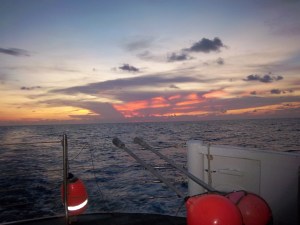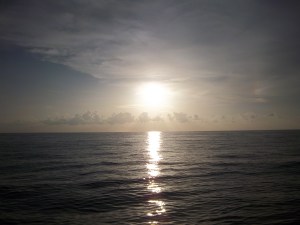NOAA Teacher at Sea
David Madden: July 18th, 2019
On board off the coast of North Carolina – about 35 miles east of Cape Fear, 40 miles south of Jacksonville, NC. (33º50’ N, 77º15’W)
Mission: South East Fisheries Independent Survey
Geographic Area of Cruise: Atlantic Ocean, SE US continental shelf ranging from Cape Hatteras, NC (35°30’ N, 75°19’W) to St. Lucie Inlet, FL (27°00’N, 75°59’W)
Here’s our location from the other day, courtesy of windy.com. And here is a good Gulf Stream explanation from our friends at NOAA:

Date: July 19, 2019
Science and Technology Log
Being at sea has got me thinking; about life at sea, the lives and careers of the men and women on board, and about the marine organisms around us. Pause there for a minute. Nature’s beauty and abundance on land is readily seen, so long as you travel to the right location and you’re patient. The ocean, however, hides its multitudes beneath the waves. I’ve found myself drawn to the ocean my whole life, and here on the cruise, I am drawn to staring at and contemplating the ocean and its life – the great hidden beneath. You know the stats: the earth is covered by ~70% water, the deep ocean has been explored less than outer space, the ocean is warming and turning more acidic, etc. I’m not saying that you and I don’t already know these things. I’m only saying that you feel them differently when you are in the ocean, when you are immersed for days in the seascape.
The goal is this cruise is to survey fish. (SEFIS = Southeast Fisheries Independent Survey). The science crew repeats a similar protocol each day of the cruise. It looks something like this:
- Chief scientist, Zeb Schobernd, determines the site locations using NOAA sea floor maps.
- The science team (broken into day and night shifts) baits six traps with menhaden fish bait, and starts the two GoPros that are attached to the traps.
- The Pisces crew then deploys the traps, 1-6, at pre-determined locations (see step 1). They do this by sliding them off the back of the ship. Traps are attached to buoys for later pick up.
- Wait for around 75 minutes.
- Pisces Senior Survey Technician, Todd Walsh, along with crew members, Mike and Junior, drop the CTD [Conductivity, Temperature, Depth] probe. See picture below.
*Stay tuned for a video chronicling this process.
6. After ~75 min, NOAA Corps officers drive back to retrieve the traps, in the order they were dropped. (1-6)
7. Crew members Mike and Junior, along with scientists, collect the fish in the trap and sort them by species.
8. All fish are measured for weight and length.
9. Depending on the species, some fish contribute further information, most notably, their otoliths (to determine age) and a sample of reproductive organs to determine maturity.
10. Rinse and repeat, four times each day, for the length of the cruise.
I mostly work with the excellent morning crew.


Here’s a view into yesterday’s fish count – more fish and more kinds of fish:

Here is a view off the back of the boat, called the stern, where the traps are dropped.

On Wednesday the GoPros on one of the fish traps collected footage of a friendly wandering tiger shark. Our camera technician, Mike Bollinger, using his stereo video technique, determined the size of the shark to be ~ 8.5 feet. I added the location’s CTD data to the picture. This is part of an upcoming video full of neat footage. See below.

Personal Log:
Things continue to be exciting on board. My mission to film flying fish flying continues (local species unknown/not really sure; probably family: Exocoetidae). But not without some mild success! I managed to get some of ‘em flying off the port side near the bow. Man are they quick. And small. And the seas were rough. Yet I remain undeterred! Here’s a picture of me waiting and watching patiently, followed by a picture of an unlucky little flying fish who abandoned sea and was left stranded at ship. Poor little fella.


General Updates:
- The seas have picked up quite a bit. Rising up to 5-6 feet. That may not seem terrifically high, but it sure does rock the ship. Good thing seas were flat at the start, allowing me to get used to life at sea.
- I just saw some dolphins! Yippie! Pictures and video to come.
- Though not legal, I’m dying to take a swim in these beautiful blue waters.
- I don’t think I’ll ever get tired of watching the ocean. *short of being stranded at sea, I suppose. See “In the Heart of the Sea: The Tragedy of the Whaleship Essex” – a true story and great book that’s may have served as inspiration for Moby Dick. I loved the book, haven’t seen the movie. Or check out the lost at sea portions of the, hard-to-believe-it-actually-happened, “Unbroken” – great book, okay movie.
Neato Facts =
NOAA Ship Pisces won NOAA ship of the year in 2018. This is no doubt due to the most excellent crew, seen below. Congratulations!

We’ve caught a number of moray eels in the fish traps. They’re super squirmy and unfriendly. Turns out they also have pharyngeal mouth parts. Essentially a second mouth that shoots after their first one is opened. Check out this fascinating look into the morey eel’s jaw biomechanics.
Please let me know if you have any questions or comments.


















































































